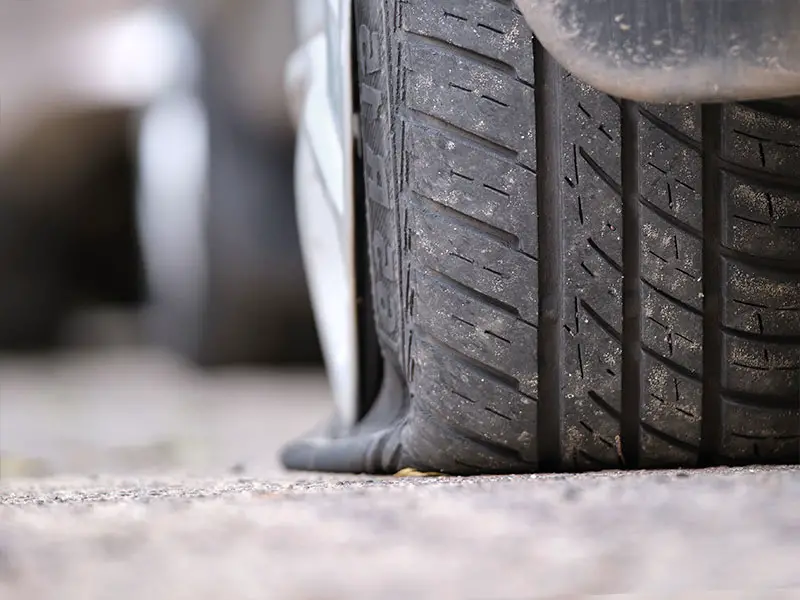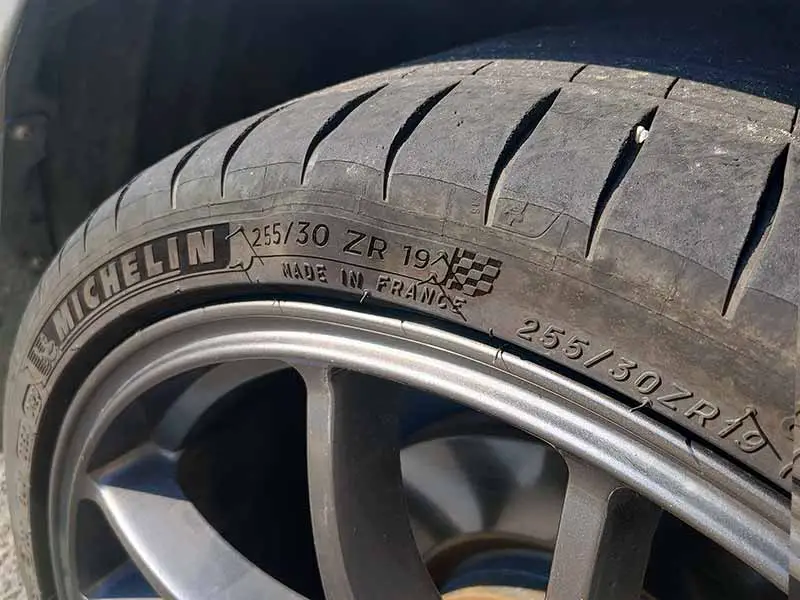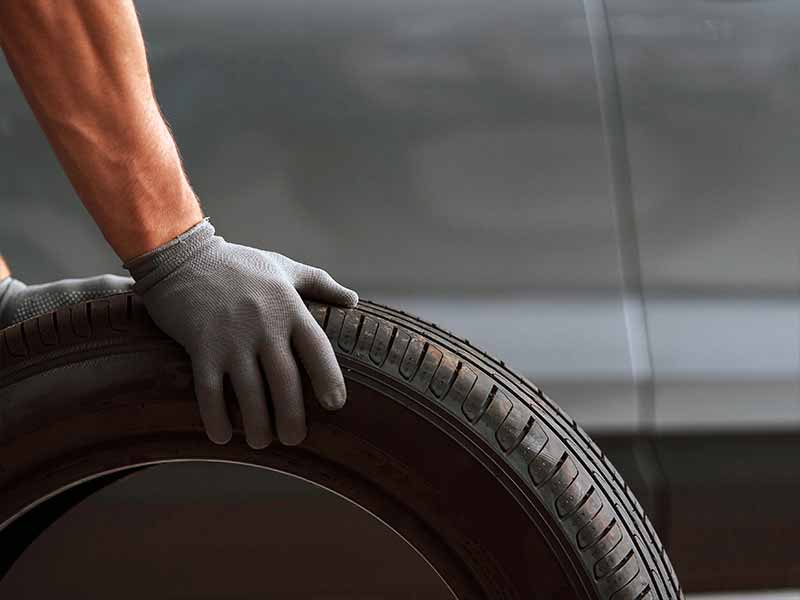I frequently see people with unrepairable flat tires or sidewall damage to a single tire. A common question I’m asked is whether to replace with one or two new tires.
While you should always refer to your owner’s manual for the manufacturer’s guidance, you can generally expect to hear me recommend replacing both tires on the same axle.
Can I Replace Just One Tire On My Car?
It’s best to replace just one tire only when the other tires are relatively new – 8/32″ wear or better. Significant differences in tread depths can affect traction control systems and anti-lock brakes.
If your other tires are worn to 4/32″ of tread depth you should consider replacing all four tires or at least the other tire on the same axle.
If you have at least one tire in decent shape you can get away with replacing one tire and using them as your back tires.
Let’s take a closer look.

Do You Have To Replace All Tires If One Is Bad?
You don’t have to replace the other three tires if you get a flat or damaged tire and the problem tire is not repairable. But it is recommended when the other tires have significant tread wear.
Large differences in tire performance and grip between different tires can make handling less predictable, especially in wet conditions.
All-wheel drive vehicles and 4x4s may require replacing all four tires due to the need to maintain traction evenly at all four tires. This has to do with the traction control and ABS software needing similar traction at each corner of the vehicle to perform properly.
Check your owner’s manual to see what your vehicle manufacturer recommends regarding replacing tires.

Should You Replace Tires In Pairs?
It isn’t required but it is recommended by most tire experts. Electronic stability programs and anti-lock braking systems work best with consistent rolling diameters and levels of grip on the same axle.
The reality is that the differences in tread wear between two tires likely won’t pose a big challenge to stability programs or mechanical differentials due to rolling diameter differences. The difference between 10/32″ and 4/32″ is quite small.
The significantly worn treads will have greatly different performance on wet or slick road surfaces, however, and this can be quite demanding for software and hardware to balance between more than one tire with large differences in tire performance.
If any of your tires are worn to 4/32″ of tread depth remaining you should consider replacing them since they are near the end of their usable life and will perform
Tires With Different Tread Depth
Tread depth has a massive effect on wet weather grip. Minor wear on a new tire has little performance loss. However, the stopping distances between new tires and a tire with 4/32″ of tread remaining are usually 50% longer on wet roads when panic braking.
Allowing your tires to wear down another 2/32″ to the legal minimum increases the wet stopping distance by another 50%. This means a completely worn tire takes twice the distance to come to a complete stop in the rain, even with ABS and traction control doing everything they can to maintain grip.
Tires With Different Tread Patterns
The tread pattern of your tires can make a difference in how well they can maintain contact with the road when it’s wet out. This is likely less important than large differences in tread wear, but tread pattern still plays a big role.
If you were to replace just one tire with another that has a different tread pattern you could have even more significant differences in grip between the new tire and the old tires. Especially if the old tires are significantly worn.
Do My Front Tires Have To Match The Rear
For front-wheel drive and rear-wheel drive cars and trucks, matching front tires with rear tires isn’t as important. It’s more important that the tires on the same axle have similar amounts of grip.
It’s also important to put the tires with the most tread on the rear axle for safety. This may seem counter-intuitive, but it is easier to control a vehicle that is understeering vs. one that is oversteering.
Understeer is where the front tires lose grip, and oversteer is where the rear tires lose grip. When a car or truck oversteers, the rear end will slide out to one side. When a vehicle understeers, it typically just slides forward, and is easier to regain control.
It should be pointed out that if your front tires don’t match the tires on the rear axle, you should avoid the forward cross or rearward cross tire rotation patterns and use the cross pattern to ensure the mismatched tires remain on the same axles as each other.
Driving With One Different Size Tire
No matter your situation, you should never mix different size tires. Slightly different tire widths are okay front to rear, but not side to side. This is assuming you have the clearance if they are wider and they will fit the wheels.
Different rolling diameters should be avoided since they would wreak havoc on the stability control systems and possibly the transfer case or differential.
What To Do If You Only Need To Replace One Tire
Only one tire needs to be replaced if at least one other tire has plenty of tread remaining. Usually a tire with 8/32″ or better tread wear.
If you only need one new tire you should pair the new tire with the tire that has the most amount of tread remaining and place both of those tires on the rear axle.
By mounting the best tires on the rear, your car or truck will be less likely to encounter oversteer. Oversteer is a loss of control due to a lack of grip in the rear that is more difficult to recover from.
When the best tires are mounted on the rear, the vehicle will more likely understeer if it loses control. Understeer is the result of poor traction at the front and usually results in the car or truck simply sliding forward.
While no loss of control is ideal, it is much safer to experience understeer than oversteer.
Replacing One Tire With A Different Brand
If you find yourself in a situation where you only need to replace one tire but the tire shop doesn’t currently have the tire brand and model in stock, you have two choices:
Replace just one tire with a different brand, or replace both tires with a different brand.
When deciding to replace one or two tires, having two tires replaced with two new tires is always preferred if your budget will allow it. This will ensure a more consistent grip by having matching tread patterns and identical rolling diameters.
You can purchase only one replacement tire with a different tread design if you must, but is less than ideal. If you do so, try to ensure that the new tire is matched with a nearly new existing tire so that the wear levels are as similar as possible on the same axle.
Replacing One Tire On FWD Or RWD
Replacing only one tire on the front-wheel drive or rear-wheel drive vehicles is less critical than on all-wheel drive vehicles, but still important. If you have the option to replace one or two tires, you should always replace two tires if your budget will allow it.
If you must replace only one tire, match the new tire with the best one of the car’s remaining tires and mount them to the rear axle. Try to match the brand and tire model with the current tires as well.
Can I Replace Just One Tire On A 4WD Or AWD?
It’s not recommended to purchase just one new tire for all-wheel drive or four-wheel drive vehicles. They are more sensitive to inconsistent rolling diameters, different tread designs, and different amounts of tire wear on the same axle.
It is acceptable to replace just one tire if the single tire being replaced is relatively new and the same model.
If push comes to shove, however, you can usually just buy one new tire to replace a damaged or flat tire, but know that the vehicle performance on wet roads may be more unpredictable.
You should always refer to your owner’s manual to determine if the vehicle manufacturer recommends replacing fewer than four tires on a 4WD or AWD vehicle.
They should also indicate whether or not it is acceptable to replace one or two tires and if so, what positions and restrictions they recommend.
Resources
Below are some links you may find helpful when learning about tires
- Should you always replace car tires in pairs? – Consumer Reports
- Do I need to replace more than one tire at a time? – Cars.com
Final Thoughts
When deciding to replace one or two tires, two is always preferred, but one is acceptable if you have another with a good amount of tread depth remaining and the tire is the same type.
It’s recommended that you replace all four tires on all-wheel drive and four-wheel drive vehicles, though it is usually acceptable to replace only two tires. Check your owner’s manual for specific recommendations and warranty requirements.
Good luck and happy motoring.






